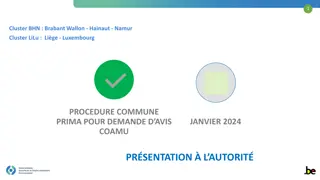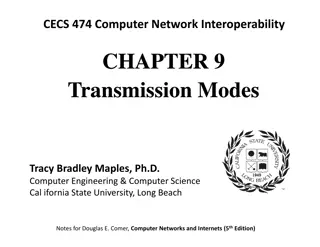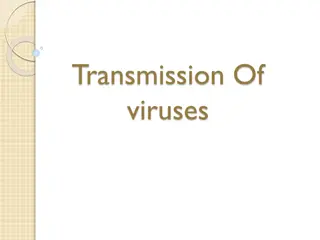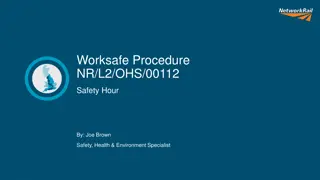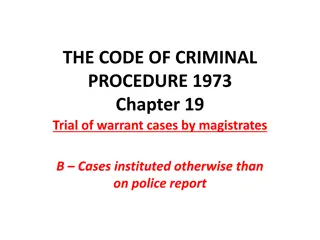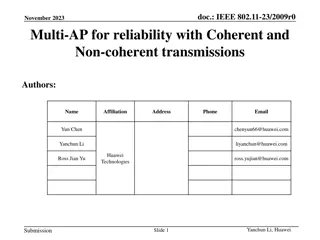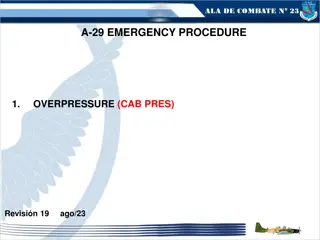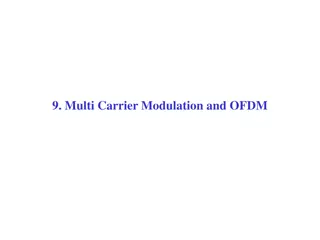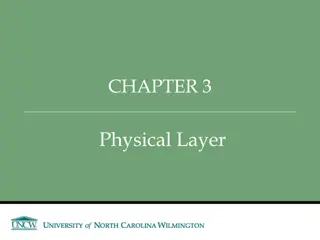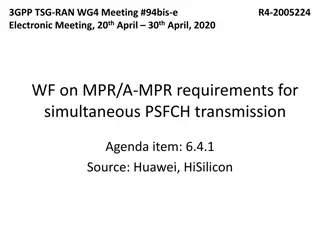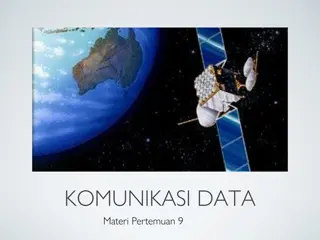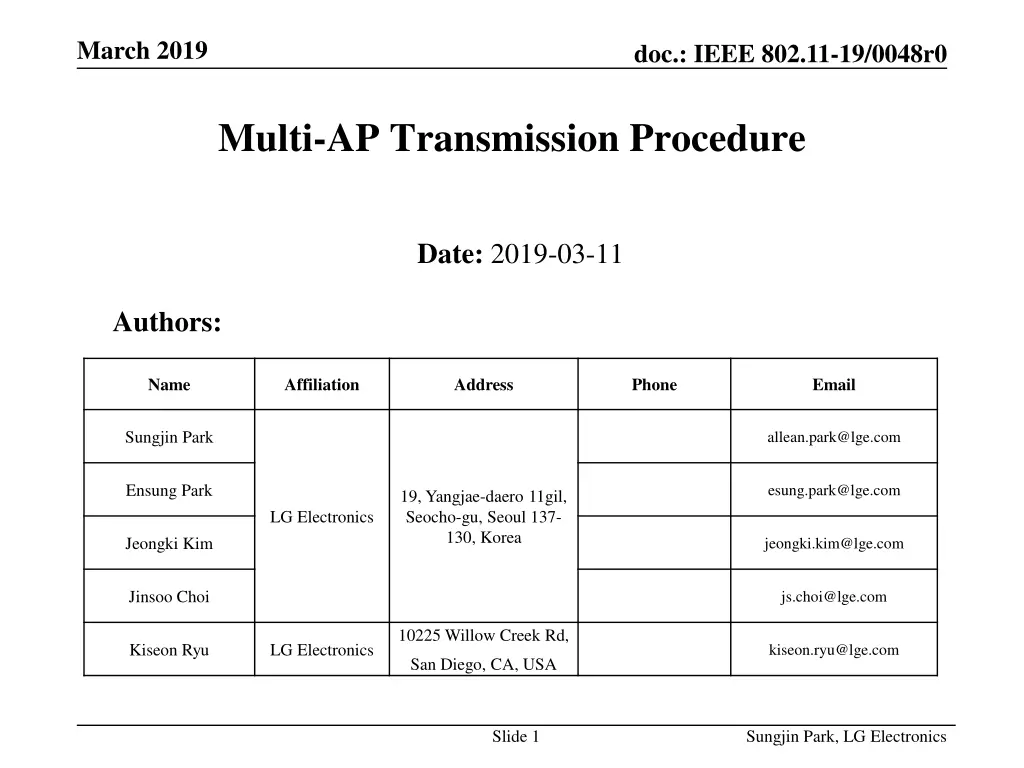
Understanding Multi-AP Transmission in IEEE 802.11 EHT Study Group
Explore the procedures and assumptions surrounding Multi-AP transmission in IEEE 802.11 EHT study group discussions, including Distributed MIMO, Coordinated BF, Coordinated OFDMA, and Coordinated SR. Learn about the multi-AP sounding procedure, environment assumptions, and selection processes for improved performance.
Download Presentation

Please find below an Image/Link to download the presentation.
The content on the website is provided AS IS for your information and personal use only. It may not be sold, licensed, or shared on other websites without obtaining consent from the author. If you encounter any issues during the download, it is possible that the publisher has removed the file from their server.
You are allowed to download the files provided on this website for personal or commercial use, subject to the condition that they are used lawfully. All files are the property of their respective owners.
The content on the website is provided AS IS for your information and personal use only. It may not be sold, licensed, or shared on other websites without obtaining consent from the author.
E N D
Presentation Transcript
March 2019 doc.: IEEE 802.11-19/0048r0 Multi-AP Transmission Procedure Date: 2019-03-11 Authors: Name Affiliation Address Phone Email Sungjin Park allean.park@lge.com Ensung Park esung.park@lge.com 19, Yangjae-daero 11gil, Seocho-gu, Seoul 137- 130, Korea LG Electronics Jeongki Kim jeongki.kim@lge.com Jinsoo Choi js.choi@lge.com 10225 Willow Creek Rd, Kiseon Ryu LG Electronics kiseon.ryu@lge.com San Diego, CA, USA Slide 1 Sungjin Park, LG Electronics
March 2019 doc.: IEEE 802.11-19/0048r0 Introduction The Multi-AP transmission has been discussed as candidate features for adoption in 802.11 EHT. [1] There are many types of Multi-AP coordinated transmission that have been discussed in EHT study group. Distributed MIMO [2], [3], [4], [7] Coordinated BF [3], [7], [8] Coordinated OFDMA [3], [5], [6], [7], [8] Coordinated SR [6], [8] To support the Multi-AP transmission in EHT, the feasible procedure needs to be discussed. Slide 2 Sungjin Park, LG Electronics
March 2019 doc.: IEEE 802.11-19/0048r0 Motivation In order that the Distributed MIMO and the Coordinated BF are used, the Multi-AP sounding procedure should be preceded. To acquire the CSI between the Slave APs and STAs In addition, the Coordinated OFDMA and the Coordinated SR also may also need the Multi-AP sounding procedure to be preceded to achieve the improvement of performance of the Multi-AP transmission. To acquire and allocate more appropriate RU/CH to the recipient STA in the Multi- AP coordination After performing the Multi-AP sounding, the Multi-AP coordinated transmission may be followed. In this contribution, we discuss the general procedure to support all types of the Multi-AP transmission schemes. Slide 3 Sungjin Park, LG Electronics
March 2019 doc.: IEEE 802.11-19/0048r0 Multi-AP environment assumption We consider the following assumptions in this document. Master AP (M-AP) - Being a role of the AP coordinator wireless Slave AP (S-AP) - Participating in the Multi-AP transmission coordinated by Master AP wireless The Slave APs which are the candidates of Multi-AP transmission can hear the master AP. The STAs which are the recipients of Multi-AP transmission can hear the Slave APs. The Master AP may not hear the STAs, but the Master AP is aware of STA s existence. The STAs may be located at the edge area in the coverage of the Slave APs. Slide 4 Sungjin Park, LG Electronics
March 2019 doc.: IEEE 802.11-19/0048r0 Multi-AP transmission procedure Multi-AP sounding Reference signal transmission from Slave APs to non-AP STAs by the Master AP s coordination Reference signal feedback from non-AP STAs to Slave APs and a Master AP Multi-AP selection Data transmitted to slave APs that are involved in the Multi-AP transmission Multi-AP transmission Distributed MIMO Coordinated BF Coordinated OFDMA Coordinated SR Slide 5 Sungjin Park, LG Electronics
March 2019 doc.: IEEE 802.11-19/0048r0 Reference signal transmission in Multi-AP sounding To achieve the improved performance of the Multi-AP coordinated transmission, the Multi-AP sounding should be performed beforehand. The M-AP transmits MAP(Multi-AP) trigger frame to the S-APs in order to initiate the sounding. A S-AP receiving the MAP trigger frame sends a MAP(Multi-AP) NDPA frame and MAP(Multi-AP) NDP packet. To acquire the channel information between each S-AP and each STA. The following slides show several options to transmit a reference signal. Slide 6 Sungjin Park, LG Electronics
March 2019 doc.: IEEE 802.11-19/0048r0 Reference signal transmission (Option 1: Transmission sequentially based on M-AP polling) MAP NDP PPDU format Slave AP 1 Slave AP 2 Slave AP 3 L-part SIG-A STF LTF L-part SIG-A STF LTF L-part SIG-A STF LTF Slide 7 Sungjin Park, LG Electronics
March 2019 doc.: IEEE 802.11-19/0048r0 Reference signal transmission (Option 2: Transmission using tone selection per S-AP) Stringent synchronization requirement among the Slave APs - Additional frames for synchronization may be needed. MAP NDP PPDU format LTF tone set for S-AP1 LTF tone set for S-AP2 LTF tone set for S-AP3 LTF tone set for S-AP1 LTF tone set for S-AP2 LTF tone set for S-AP3 LTF tone set for S-AP1 LTF tone set for S-AP2 LTF tone set for S-AP3 Slave AP 1 Slave AP 2 Slave AP 3 L-part SIG-A STF Slide 8 Sungjin Park, LG Electronics
March 2019 doc.: IEEE 802.11-19/0048r0 Reference signal transmission (Option 3: Transmission using DL MU-MIMO LTF) Stringent synchronization requirement among the Slave APs - Additional frames for synchronization may be needed. Total number of LTF symbols depends on the sum of antennas of all Slave APs MAP NDP PPDU format Slave AP 1 Slave AP 2 Slave AP 3 L-part SIG-A STF LTF LTF LTF Slide 9 Sungjin Park, LG Electronics
March 2019 doc.: IEEE 802.11-19/0048r0 Comparison of reference signal transmission options Option 1 Option 2 Option 3 Option 4 [2] - Reusing conventional NDP per S-AP - Transmitting each NDP consecutively - Reusing conventional NDP with assigning different tones to each S-AP - Transmitting NDP at the same time - Reusing conventional NDP(Considering all S-APs as one AP) - Transmitting NDP at the same time - Reusing UL MU- MIMO LTF in NDP - Transmitting NDP at the same time Descriptions - Depending on the total number of participating S-APs, the time overhead increase gradually - Depending on the coherent BW, the accuracy of channel estimation is affected - Stringent synchronization - Need fine residual CFO compensation in each S-AP before NDP transmission - Stringent synchronization - High complexity at STA for CFO measure between each S-AP and itself - Stringent synchronization Considerations The reference signal transmission should be defined considering time overhead, complexity both on AP side and STA side and channel estimation accuracy. Slide 10 Sungjin Park, LG Electronics
March 2019 doc.: IEEE 802.11-19/0048r0 Reference signal feedback in Multi-AP sounding The recipient STA should send a MAP reference feedback frame to its associated S-AP in response to the MAP NDPA frames and the MAP NDP packets. The S-AP receiving the MAP reference feedback frame from the recipient STA should send it to M-AP. The feedback information will also be used to determine the Multi-AP transmission type. M-AP can send a MAP feedback trigger to receive MAP reference feedback simultaneously. Slide 11 Sungjin Park, LG Electronics
March 2019 doc.: IEEE 802.11-19/0048r0 Example of reference signal feedback procedure Using UL OFDMA MAP reference feedback contents S-AP 1 feedback S-AP 2 feedback S-AP 3 feedback S-AP 1 feedback S-AP 2 feedback S-AP 3 feedback STA b STA a Slide 12 Sungjin Park, LG Electronics
March 2019 doc.: IEEE 802.11-19/0048r0 Multi-AP selection The M-AP can inform S-APs of being selected for the Multi-AP transmission. The M-AP decides which S-APs are suitable for the Multi-AP transmission based on the channel feedback between the each S-AP and each STA. For it, M-AP sends to the selected S-APs the Data frame containing the Multi-AP selection information. (E.g., the recipient STA s identification) S-APs send to M-AP a BA frame in response to the Data frame. M-AP can reselect the S-AP based on the reception of BA. Slide 13 Sungjin Park, LG Electronics
March 2019 doc.: IEEE 802.11-19/0048r0 Example of Multi-AP selection Data transmission to Slave AP 1 and Slave AP 2 which are selected BA frames may be sent by UL OFDMA Slide 14 Sungjin Park, LG Electronics
March 2019 doc.: IEEE 802.11-19/0048r0 Multi-AP transmission The M-AP initiates the Multi-AP transmission by sending the MAP trigger frame. Including the Multi-AP transmission type (e.g., Distributed MIMO, Coordinated BF, Coordinated OFDMA, or Coordinated SR, etc.) May include the information for the recipient STAs to send BlockAck (e.g., RU allocation, etc.) Slave-AP includes this information in the Multi-AP data frame and STA sends a BlockAck in response to Multi-AP data frame by using this information. And then Slave-APs that received the MAP trigger frame send the data by using the Multi-AP transmission. Including the information for decoding the PSDU (e,g., the recipient STAs ID(s) and the transmission information such as MCS, PSDU length, Nss, and etc.) May need new PPDU format when the trigger based PPDU cannot include this information. Slide 15 Sungjin Park, LG Electronics
March 2019 doc.: IEEE 802.11-19/0048r0 Example of Multi-AP transmission procedure M-AP indicates which MAP TX would be used M-AP controls the STAs for sending BA Including the information for decoding PSDU per each STA Slide 16 Sungjin Park, LG Electronics
March 2019 doc.: IEEE 802.11-19/0048r0 Conclusion We discussed a general procedure with the Multi-AP sounding, Multi-AP selection, and Multi-AP transmission to support all types of the Multi-AP transmissions. Detailed procedure for each type of the Multi-AP transmission needs further study. Slide 17 Sungjin Park, LG Electronics
March 2019 doc.: IEEE 802.11-19/0048r0 Reference [1] IEEE 802.11-18/1231r1, EHT draft proposed PAR, Laurent Cariou (Intel) [2] IEEE 802.11-18/1439r0, Constrained Distributed MU-MIMO, Ron Porat (Broadcom) [3] IEEE 802.11-18/1926r2, Terminology for AP Coordination, Sameer Vermani (Qualcomm) [4] IEEE 802.11-18/1510r1, AP Coordinated beamforming for EHT, Hongyuan Zhang (Marvell) [5] IEEE 802.11-18/1155r1, Multi-AP Enhancement and Multi-Band Operations, Jianhan Liu (Mediatek) [6] IEEE 802.11-19/103r0, AP-Coordination-in-EHT, Jason Yuchen Guo (Huawei) [7] IEEE 802.11-18/1461r1, Discussions on the PHY Features for EHT, Xiaogang Chen (Intel) [8] IEEE 802.11-19/0071r0, Coordinated Multi-AP Transmission for EHT, Kome Otri (InterDigital) Slide 18 Sungjin Park, LG Electronics



